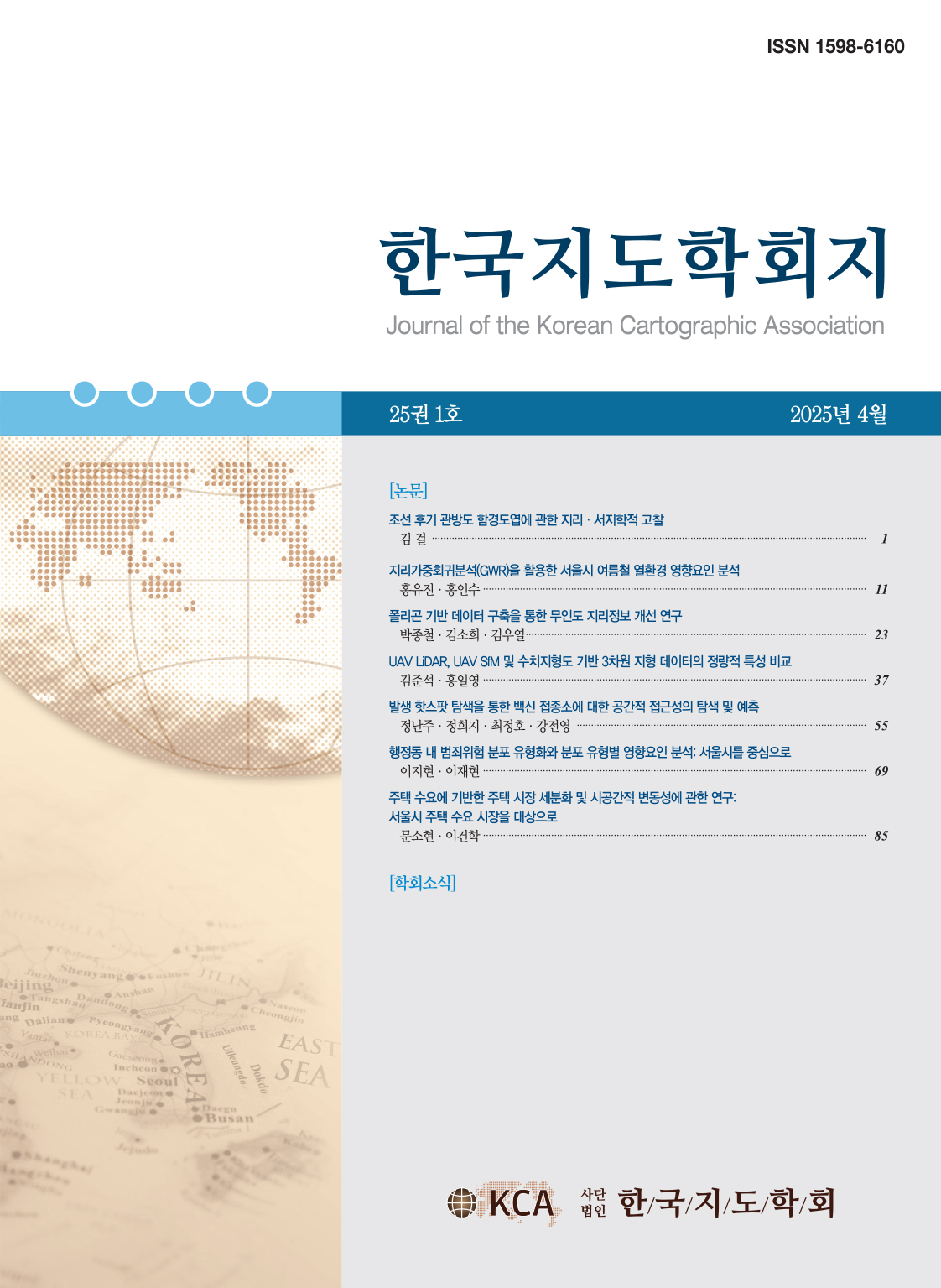Research Article
Abstract
References
Information
Recently, individual-level analysis and demand for fine-scale spatial data have increased, but most of the currently accessible data is aggregated on the basis of administrative units. In order to overcome these difficulties associated with data procurement, this study proposes a method to generate fine-scale spatial data by integrating easily accessible open data. The building selection algorithm that estimates the destination of a trip by building unit is based on areal interpolation and dasymetric mapping. The weights for the building selection process are derived from various ancillary data. The results showed that the proposed algorithm is more accurate than the existing interpolation method. This study suggests a new population estimation model based on trip records and has a significance in that high-resolution data is generated by combining various easily accessible data.
최근 미시적 규모의 연구가 증가하며 기존보다 세밀한 공간 단위의 데이터에 대한 요구가 증가하였지만, 현재 접근 가능한 대부분의 공간 데이터는 행정구역 단위를 기반으로 집계되어 제공되고 있다. 따라서 고해상도 공간 데이터를 얻기 위해 기존의 공간 데이터를 세밀한 공간 단위로 전환하는 연구가 활발히 진행되어 왔다. 본 연구에서는 다양한 공간 데이터의 융합을 통해 직장인구를 건물 단위로 추정하는 알고리즘을 제시한다. 개별 통행의 목적지를 건물 단위로 추정하는 건물선택 알고리즘은 영역내삽법과 대시메트릭 매핑을 기반으로 하며, 보조 데이터를 통해 건물별로 가중치를 정의한 뒤 이를 기반으로 통행의 목적지를 추정하였다. 본 연구는 통행을 기반으로 하며 기존의 내삽법에 비해 높은 정확도를 보이는 새로운 인구 추정 모형을 제시하고, 쉽게 접근할 수 있는 다양한 데이터를 결합하여 고해상도 데이터를 생성한다는 점에서 의의를 지닌다.
- 김경태・이인묵・곽호찬・민재홍, 2016, “이동통신 자료 전수화를 통한 존재인구 산정 방안,” 대한교통학회지, 34(3), 222-233.
- 김예린, 2019, “건물 단위 직장인구 추정을 위한 공간데이터 융합 모형설계,” 경희대학교 석사학위논문.
- 김재익・권진휘, 2013, “수도권 통근통행의 공간적 변화와 직주분리수준의 분석,” 교통연구, 20(4), 79-90.
- 김현우・김호연, 2011, “수도권 신도시 건설과 서울 거주자의 통근통행패턴 변화,” 한국경제지리학회지, 14(3), 437-451.
- 변미리・서우석, 2011, “도시 거리의 주간활동인구 측정과 해석: 서울시 유동인구 조사 사례,” 조사연구, 12(2), 27-50.
- 성현곤, 2013, “주거와 직장의 대중교통 접근성 유형화와 대중교통 통행발생량과의 연관성에 관한 연구,” 대한교통학회지, 31(2), 20-32.
- 오병록, 2014, “가구통행실태조사 자료를 이용한 통행특성 분석과 생활권 기준 설정 연구,” 서울도시연구, 15(3), 1-18.
- 이건학・김감영, 2016, “공간통계 기법을 이용한 현주인구 추정 모델링,” 한국지도학회지, 16(2), 71-93.
- 이경환, 2013, “근린의 토지이용과 대중교통시설 보행접근성이 통근통행에 미치는 영향,” 한국산학기술학회 논문지, 14(9), 4593-4601.
- 이상일・김감영, 2007, “GIS-기반대시메트릭 매핑(dasymetric mapping) 기법을 이용한 서울시 인구밀도 분포의 재현,” 한국지도학회지, 7(2), 53-67.
- 이석준・이상욱・홍보영・엄홍민・신휴석・김경민, 2014, “대시메트릭 매핑 기법을 이용한 서울시 건축물별 주거인구밀도의 재현,” 한국공간정보학회지, 22(3), 89-99.
- 조대헌, 2011, “유동 패턴 분석 방법으로서의 요인 분석에 대한 비판적 검토,” 한국지도학회지, 11(1), 33-46.
- 최돈정・김영섭・서용철, 2011, “벡터기반 대시매트릭 기법을 이용한 소지역 장수인구 추정 및 분포패턴에 관한 연구,” 한국측량학회지, 29(5), 479-485.
- 추상호・권세나・김동호, 2008, “통행사슬 특성 분석에 관한 연구: 서울시 사례를 중심으로,” 대한교통학회지, 26, 87-97.
- Akkerman, A., 1995, The urban household pattern of daytime population change, The Annals of Regional Science, 29(1), 103-117.10.1007/BF01580360
- Bakillah, M., Liang, S., Mobasheri, A., Jokar Arsanjani, J., and Zipf, A., 2014, Fine-resolution population mapping using OpenStreetMap points-of-interest, International Journal of Geographical Information Science, 28(9), 1940-1963.10.1080/13658816.2014.909045
- Bhaduri, B., 2008, Population distribution during the day, Encyclopedia of GIS, Boston, MA: Springer, 880-885.10.1007/978-0-387-35973-1_1005
- Bhaduri, B., Bright, E., Coleman, P., and Urban, M.L., 2007, LandScan USA: a high-resolution geospatial and temporal modeling approach for population distribution and dynamics, GeoJournal, 69(1-2), 103-117.10.1007/s10708-007-9105-9
- Deng, Z. and Ji, M., 2010, Deriving Rules for Trip Purpose Identification from GPS Travel Survey Data and Land Use Data: A Machine Learning Approach, Proceedings, 7th International Conference on Traffic and Transportation Studies, August 3-5, Kunming, China, 768-777.10.1061/41123(383)73
- Flowerdew, R. and Green, M., 1994, Areal interpolation and types of data, in Fotheringham, S. and Rogerson, P. eds., Spatial analysis and GIS, London: Taylor and Francis, 121-145.10.4324/9780203221563_chapter_7
- Foley, D.L., 1952, The daily movement of population into central business districts. American sociological review, 17(5), 538-543.10.2307/2088219
- Greger, K., 2015, Spatio‐Temporal Building Population Estimation for Highly Urbanized Areas Using GIS, Transactions in GIS, 19(1), 129-150.10.1111/tgis.12086
- Hawley, K. and Moellering, H., 2005, A comparative analysis of areal interpolation methods, Cartography and Geographic Information Science, 32(4), 411-423.10.1559/152304005775194818
- Jenks, G.F., 1967, The data model concept in statistical mapping, International yearbook of cartography, 7, 186-190.
- Lam, N.S.N., 1983, Spatial interpolation methods: a review, The American Cartographer, 10(2), 129-150.10.1559/152304083783914958
- Lee, J.G. and Kang, M., 2015, Geospatial big data: challenges and opportunities, Big Data Research, 2(2), 74-81.10.1016/j.bdr.2015.01.003
- Lu, Z., Im, J., Quackenbush, L., and Halligan, K., 2010, Population estimation based on multi-sensor data fusion, International Journal of Remote Sensing, 31(21), 5587-5604.10.1080/01431161.2010.496801
- Lwin, K. and Murayama, Y., 2009, A GIS Approach to Estimation of Building Population for Micro spatial Analysis, Transactions in GIS, 13(4), 401-414.10.1111/j.1467-9671.2009.01171.x
- Martin, D., 2011, Directions in population GIS, Geography Compass, 5(9), 655-665.10.1111/j.1749-8198.2011.00440.x
- McPherson, T.N. and Brown, M.J., 2003, Estimating daytime and nighttime population distributions in US cities for emergency response activities (No. LA-UR-03-8388), Los Alamos National Laboratory (LANL), Los Alamos, NM: United States.
- Roddis. S. and Richardson, A., 1998, Construction of daytime activity profiles from household travel survey data, Transportation Research Record, 1625, 102-108.10.3141/1625-13
- Sleeter, R. and Wood, N., 2006, Estimating daytime and nighttime population density for coastal communities in Oregon, Proceedings, 44th Annual Conference of the Urban and Regional Information Systems Association, September 26-29, Vancouver, Canada, 1-15.
- Sridharan, H. and Qiu, F., 2013, A Spatially Disaggregated Areal Interpolation Model Using Light Detection and Ranging-Derived Building Volumes, Geographical Analysis, 45(3), 238-258.10.1111/gean.12010
- Susilo, Y. and Kitamura, R., 2005, Analysis of day-to-day variability in an individual’s action space: exploration of 6-week Mobidrive travel diary data, Transportation Research Record: Journal of the Transportation Research Board, 1902(1), 124-133.10.3141/1902-15
- Ural, S., Hussain, E., and Shan, J., 2011, Building population mapping with aerial imagery and GIS data, International Journal of Applied Earth Observation and Geoinformation, 13(6), 841-852.10.1016/j.jag.2011.06.004
- Wei, Q.I., Shenghe, L.I.U., Xiaolu, G.A.O., and Meifeng, Z.H.A.O., 2015, Modeling the spatial distribution of urban population during the daytime and at night based on land use: A case study in Beijing, China, Journal of Geographical Sciences, 25(6), 756-768.10.1007/s11442-015-1200-0
- Wirth, L., 1938, Urbanism as a Way of Life, American Journal of Sociology, 44(1), 1-24.10.1086/217913
- Publisher :The Korean Cartographic Association
- Publisher(Ko) :한국지도학회
- Journal Title :Journal of the Korean Cartographic Association
- Journal Title(Ko) :한국지도학회지
- Volume : 19
- No :2
- Pages :91~104
- DOI :https://doi.org/10.16879/jkca.2019.19.2.091



 Journal of the Korean Cartographic Association
Journal of the Korean Cartographic Association





